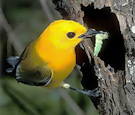Features

Old Growth Forest
One of the largest tracts
of old growth forest in the South, the Dance Bayou tract has 300+ documented
species of flowering plants.
Learn
More

Crossing the Gulf
Migratory birds exhausted
from the 600-mile crossing of the Gulf of Mexico find food, shelter and fresh
water in the refuge bottomlands.

Get a closer look!
Get up close and personal
with some of the refuge's wild residents and the habitat they depend
upon.
View
the Gallery

Still Wild
Clouds of snow geese in the winter
or warbler “fallouts” in the spring convince refuge visitors they have stepped
back in time.

Where Wildlife Comes First
National Wildlife
Refuges are managed for wildlife and habitat and to ensure future generations
will always have wild places to explore!
Visitor
Activities

San Bernard National
Wildlife is part of the Texas Mid-coast Refuge Complex, which also includes
Brazoria and Big Boggy Refuges. For more information on the three refuges,
contact the U.S. Fish and Wildlife Service.
Contact UsAbout the NWRS

The National Wildlife Refuge System, within the U.S. Fish and Wildlife Service, manages a national network of lands and waters set aside to conserve America’s fish, wildlife, and plants.
Learn more about the NWRS

The San Bernard NWR will be accepting applications for the Sargent Permit Hunt Area during the month of September. Waterfowl season opens on November 5, 2016.
Waterfowl Hunting
Sidney Gauthreaux, a Clemson
University scientist, uses weather service radar scans to calculate spring
migration. He calculates an astonishing 239 million birds pass through the
Columbia Bottomlands each spring. Able to watch the migration on radar in real
time, the birds all seem to leave the bottomlands in an ‘exodus’ event, which
is about a half-hour to forty-five minutes after sunset on a southerly wind.
The migratory birds lift off at nearly the same time in a wheel-shaped
formation that might include as many as quarter of a million birds. Considered
the founder of radar ornithology, Gauthreaux also estimates that neotropical
songbird migration decreased by half from 1979 to 1995.

The prothonotary warbler was
actually named for a group of Catholic clerics who wore bright yellow? The
brilliant yellow bird is one of many migratory birds that depend on the refuge’s
bottomland hardwood forest.

State Champion Live Oak
Declared the largest
live oak in Texas in 2000, the champion tree has a circumference greater than 32
feet and stands at least 67 feet high. The ancient tree is situated in shallow
bodies of water, remnants of shifting river and bayou channels. It has provided
shelter to countless numbers of migratory birds that find a place to rest and
feed within its amazing crown that extends more than 100 feet.
Page Photo Credits — All photos courtesy of USFWS unless otherwise noted., Linville Bayou Unit, Roseate spoonbill female with chicks, Old growth forest, Scarlet Tanager / Allen Dale ©, Snow geese, Indian blanket flowers / Lavaty ©, Kayaking on the refuges, Chestnut-sided / Scott Buckel ©, Prothonotary warbler / USFWS, Live oak on Hudson Woods / USFWS
Last Updated: Jul 07, 2015